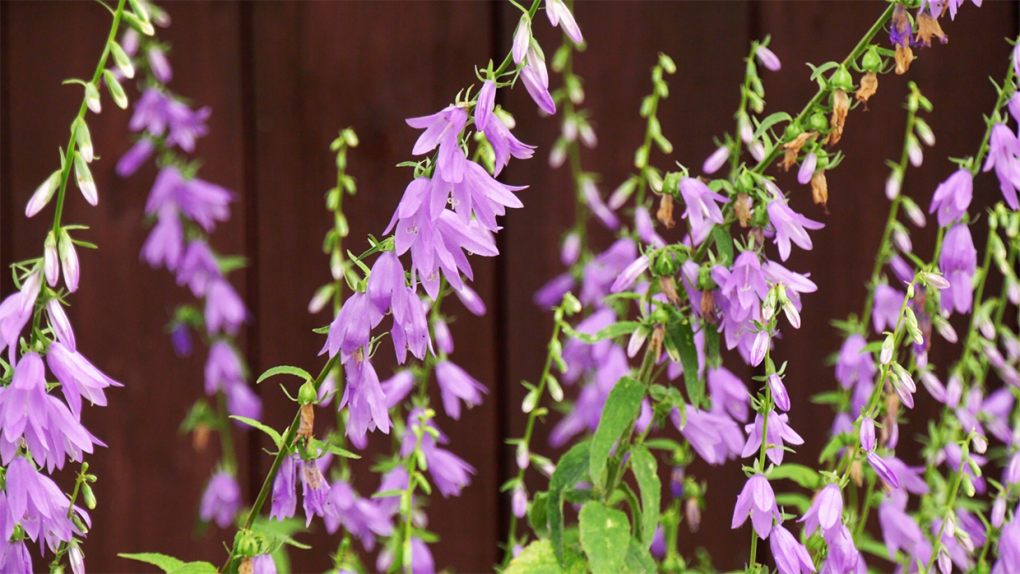Seek and destroy: Beware the creeping bellflower, the attractive and invasive garden guest you can't get rid of
The creeping bellflower plant can take over yards and suck the life out of more desirable plants in a short period of time because it is extremely invasive. It’s now blooming and about to seed. Horticulturalist John Ostrowdun says now is a good time to get the word out to all Calgarians – gardeners and non-gardeners alike.
Ostrowdun says the plant's pretty appearance may trick some into believe it is harmless, “People give it to their friends, because it's a beautiful perennial, which is why it spreads as fast as it does. And once you get it, it's quite hard to get rid of.”
According to Ostrowdun once you have creeping bellflower in your garden, getting rid of it may not be easy, “It's a lot of manual labor, a lot of chemical treatment, and then just keeping up on it," he said. "I know in my own yard, when I first bought my house it took me a good five years of hard work to get it, where it's now manageable. It still pops up once in a while, I still periodically find it in my yard and I just remove it right away when I see it.”
Creeping Bellflower or campanula rapunculoides is a low-growing clumped foliage in spring and grows to one metre tall flowering spike in early summer. The plant's leaves are heart-shaped in early stage and become more lance-shaped, tooth-edged and coarse textured as they mature.
 Creeping bellflower, July 21, 2021
Creeping bellflower, July 21, 2021
The flowers are purple-blue, two-to-three centimetres long nodding bells and blooms begin on the plants lower stem.
According to the city of Calgary pest management website,” Once established, creeping bellflower is very difficult to remove as even the smallest tiny root fragments can grow entirely new plants. It also spreads very easily as each stem produces up to 15,000 seeds. Creeping bellflower is also resistant to some herbicides.
Creeping bellflower is also known as garden bluebell, rover bellflower, purple bell, garden harebell, creeping campanula, creeping bluebell.”
Ostrowdun said if you enjoy the look of this plant but not the way it's been taking over your yard, you do have some alternatives to consider, “(There are) some campanula that aren't as aggressive but look like this, things like delphiniums work really well, penstemons work really well, if you like that same look.” So there are quite a few options you can use in the garden to replace that plant that you may enjoy.
CTVNews.ca Top Stories

In Pictures Jake Paul beats 58-year-old Mike Tyson as the hits don't match the hype
The boos from a crowd wanting more action were growing again when Jake Paul dropped his gloves before the final bell, and bowed toward 58-year-old Mike Tyson.
Montreal city councillors table motion to declare state of emergency on homelessness
A pair of independent Montreal city councillors have tabled a motion to get the city to declare a state of emergency on homelessness next week.
Canadians support bike infrastructure, just not the road: study
A new Nanos Research study reveals that a majority of Canadians support spending tax dollars on building bicycle infrastructure off the road, but that bike lanes on roads worsen traffic flow.
WestJet passengers can submit claims now in $12.5M class-action case over baggage fees
Some travellers who checked baggage on certain WestJet flights between 2014 and 2019 may now claim their share of a class-action settlement approved by the British Columbia Supreme Court last month and valued at $12.5 million.
Turtle plush toys recalled due to choking hazard: Health Canada
Health Canada announced a consumer product recall this week for a plush children’s toy, due to a potential choking hazard from the eyes of the toy detaching.
U.S. health officials report first case of new form of mpox in a traveler
Health officials said Saturday they have confirmed the first U.S. case of a new form of mpox that was first seen in eastern Congo.
Former soldier 'Canadian Dave' taken by the Taliban: sources
David Lavery, a former Canadian Forces soldier who helped approximately 100 people flee Afghanistan during the fall of Kabul, has been 'picked up' by the Taliban this week, according to multiple sources who spoke to CTV National News on the condition of anonymity.
NYC politicians call on Whoopi Goldberg to apologize for saying bakery denied order over politics
New York City politicians are calling on Whoopi Goldberg to apologize for suggesting that a local bakery declined a birthday order because of politics.
Trudeau talking trade with South American leaders at APEC in Peru, will address media
Prime Minister Justin Trudeau is meeting with South American leaders in Peru today, in his second day at the Asia-Pacific Economic Cooperation summit.































